Kenzō Tange
Kenzō Tange (丹下 健三, Tange Kenzō, 4 September 1913 – 22 March 2005) was a Japanese architect, and winner of the 1987 Pritzker Prize for architecture. He was one of the most significant architects of the 20th century, combining traditional Japanese styles with modernism, and designed major buildings on five continents. His career spanned the entire second half of the twentieth century, producing numerous distinctive buildings in Tokyo, other Japanese cities and cities around the world, as well as ambitious physical plans for Tokyo and its environs.[1] Tange was also an influential patron of the Metabolist movement. He said: "It was, I believe, around 1959 or at the beginning of the sixties that I began to think about what I was later to call structuralism", (cited in Plan 2/1982, Amsterdam), a reference to the architectural movement known as Dutch Structuralism.
Kenzō Tange | |
|---|---|
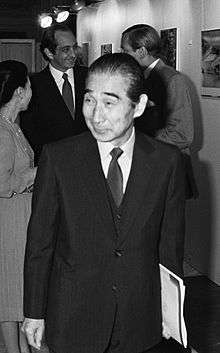 Kenzo Tange in Amsterdam in 1981 | |
| Born | 4 September 1913 Osaka, Japan |
| Died | 22 March 2005 (aged 91) Tokyo, Japan |
| Alma mater | The University of Tokyo |
| Occupation | Architect |
| Awards | Pritzker Prize, RIBA Gold Medal, AIA Gold Medal, Order of Culture, Praemium Imperiale, Order of Sacred Treasures |
| Practice | 1946 Tange Laboratory 1961 The Urbanists and Architects Team Kenzo Tange Associates |
| Buildings | Hiroshima Peace Memorial Park, Plan for Skopje, Tokyo Olympic arenas, St Mary's Cathedral |
Influenced from an early age by the Swiss modernist, Le Corbusier, Tange gained international recognition in 1949 when he won the competition for the design of Hiroshima Peace Memorial Park. He was a member of CIAM (Congres Internationaux d'Architecture Moderne) in the 1950s. He did not join the group of younger CIAM architects known as Team X, though his 1960 Tokyo Bay plan was influential for Team 10 in the 1960s, as well as the group that became Metabolism.
His university studies on urbanism put him in an ideal position to handle redevelopment projects after the Second World War. His ideas were explored in designs for Tokyo and Skopje. Tange's work influenced a generation of architects across the world.
Early life
Born on 4 September 1913 in Osaka, Japan, Tange spent his early life in the Chinese cities of Hankow and Shanghai; he and his family returned to Japan after learning of the death of one of his uncles. In contrast to the green lawns and red bricks in their Shanghai abode, the Tange family took up residence in a thatched roof farmhouse in Imabari on the island of Shikoku.[2]
After finishing middle school, Tange moved to Hiroshima in 1930 to attend high school. It was here that he first encountered the works of Swiss modernist, Le Corbusier. His discovery of the drawings of the Palace of the Soviets in a foreign art journal convinced him to become an architect. Although he graduated from high school, Tange's poor results in mathematics and physics meant that he had to pass entrance exams to qualify for admission to the prestigious universities. He spent two years doing so and during that time, he read extensively about western philosophy. Tange also enrolled in the film division at Nihon University's art department to dodge Japan's drafting of young men to its military and seldom attended classes.[2]
In 1935 Tange began the tertiary studies he desired at University of Tokyo's architecture department. He studied under Hideto Kishida and Shozo Uchida.[2] Although Tange was fascinated by the photographs of Katsura villa that sat on Kishida's desk, his work was inspired by Le Corbusier. His graduation project was a seventeen-hectare (42-acre) development set in Tokyo's Hibiya Park.[3]
Early career
After graduating from the university, Tange started to work as an architect at the office of Kunio Maekawa. During his employment, he travelled to Manchuria, participating in an architectural design competition for a bank, and toured Japanese-occupied Jehol on his return. When the Second World War started, he left Maekawa to rejoin the University of Tokyo as a postgraduate student. He developed an interest in urban design, and referencing only the resources available in the university library, he embarked on a study of Greek and Roman marketplaces.[3] In 1942, Tange entered a competition for the design of the Greater East Asia Co-Prosperity Sphere Memorial Hall. He was awarded first prize for a design that would have been situated at the base of Mount Fuji; the hall he conceived was a fusion of Shinto shrine architecture and the plaza on Capitoline Hill in Rome. The design was not realised.[4]
In 1946, Tange became an assistant professor at the university and opened Tange Laboratory. In 1963, he was promoted to professor of the Department of Urban Engineering. His students included Sachio Otani, Kisho Kurokawa, Arata Isozaki, Hajime Yatsuka and Fumihiko Maki.[5]
Post war reconstruction
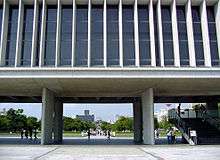
Tange's interest in urban studies put him in a good position to handle post war reconstruction. In the summer of 1946 he was invited by the War Damage Rehabilitation Board to put forward a proposal for certain war damaged cities. He submitted plans for Hiroshima and Maebashi.[6] His design for an airport in Kanon, Hiroshima was accepted and built, but a seaside park in Ujina was not.[7]
The Hiroshima authorities took advice about the city's reconstruction from foreign consultants, and in 1947 Tam Deling, an American park planner, suggested they build a Peace Memorial and preserve buildings situated near ground zero, that point directly below the explosion of the atomic bomb.[8] In 1949 the authorities enacted the Hiroshima Peace Memorial Reconstruction Act, which gave the city access to special grant aid, and in August 1949, an international competition was announced for the design of the Hiroshima Peace Memorial Park.[9]
Tange was awarded first prize for a design that proposed a museum whose axis runs through the park, intersecting Peace Boulevard and the atomic bomb dome. The building is raised on massive columns, which frame the view along the structure's axis.[10]
Projects
Centro Direzionale (Naples)
| Wikimedia Commons has media related to Category:Centro direzionale (Naples). |
The Centro Direzionale (Naples) is a service center in Naples, Italy. The district is mainly devoted to business. The project of the Centro Direzionale dates back to 1964. It was designed in 1982 by Tange. The layout includes 18 blocks of buildings, with high-rises up to 100 meters. There are office buildings as well as residential flats. The Center is meant to accommodate most, if not all, of the administrative offices of the city of Naples, such as the new Hall of Justice. It also includes a pedestrian zone at ground level with shops, restaurants and hotels. There is an underground parking facility with escalators running up into the middle of the large pedestrian concourse, an area adorned with fountains, benches, greenery and a church. The Centro Direzionale is home to the tallest building in southern Italy, the Telecom Italia Tower.
Peace Center in Hiroshima

Work on the Peace Center commenced in 1950. In addition to the axial nature of the design, the layout is similar to Tange's early competition arrangement for the Greater East Asia Co-Prosperity Sphere Memorial Hall.[11]
In the initial design the Hiroshima Peace Memorial Museum was dominated by adjoining utility buildings, which were linked to it by high-level walkways. Tange refined this concept to place the museum prominently at the centre, separate from the utility buildings (only one of which was subsequently designed by him). In addition to architectural symbolism, he thought it important for the design to centre around the building that houses the information about the atomic explosion.[12]
The museum is constructed from bare reinforced concrete. The primary museum floor is lifted six metres above the ground on huge piloti and is accessible via a free-standing staircase. The rhythmical facade comprises vertical elements that repeat outwards from the centre. Like the exterior, the interior is finished with rough concrete; the idea was to keep the surfaces plain so that nothing could distract the visitor from the contents of the exhibits.[13]
The Peace Plaza is the backdrop for the museum. The plaza was designed to allow 50 thousand people to gather around the peace monument in the centre. Tange also designed the monument as an arch composed of two hyperbolic paraboloids, said to be based on traditional Japanese ceremonial tombs from the Kofun Period.[13]
Ise Shrine
In 1953 Tange and the architectural journalist and critic Noboru Kawazoe were invited to attend the reconstruction of the Ise Shrine. The shrine has been reconstructed every 20 years and in 1953 it was the 59th iteration. Normally the reconstruction process was a very closed affair but this time the ceremony was opened to architects and journalists to document the event. The ceremony coincided with the end of the American Occupation and it seemed to symbolise a new start in Japanese architecture. In 1965 when Tange and Kawazoe published the book Ise: Prototype of Japanese Architecture, he likened the building to a modernist structure: an honest expression of materials, a functional design and prefabricated elements.[14]
Kagawa Prefectural Government Hall
The Kagawa Prefectural Government Hall on the island of Shikoku was completed in 1958. Its expressive construction could be likened to the Daibutsu style seen at the Tōdai-ji in Nara.[15] The columns on the elevation bore only vertical loads so Tange was able to design them to be thin, maximising the surfaces for glazing. Although the hall has been called one of his finest projects,[16] it drew criticism at the time of its construction for relying too heavily on tradition.[17]
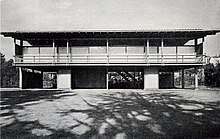
Tange's own home
Tange's own home, designed in 1951 and completed in 1953, uses a similar skeleton structure raised off the ground as the Hiroshima Peace Museum; however, it is fused with a more traditional Japanese design that uses timber and paper. The house is based on the traditional Japanese module of the tatami mat, with the largest rooms designed to have flexibility so that they can be separated into three smaller rooms by fusuma sliding doors.[18] The facade is designed with a rhythmic pattern; it comprises two types of facade designs ("a" and "b") that are ordered laterally in an a-b-a-a-b-a arrangement. The house is topped with a two-tier roof. Kazuo Shinohara's 1954 house at Kugayama is remarkably similar in its design, although it is built with steel and has a simpler rhythm in its facade.[19]
Town Hall, Kurashiki
The fortress-like town hall in Kurashiki was designed in 1958 and completed in 1960. When it was constructed it was situated on the edge of the old town centre connecting it with the newer areas of the town. Kurashiki is better known as a tourist spot for its old Machiya style houses.[20]
Set in an open square, the building sits on massive columns that taper inwards as they rise. The elevation consists of horizontal planks (some of which are omitted to create windows) which overlap at the corners in a "log cabin" effect. The entrance is covered with a heavy projecting concrete canopy which leads to a monumental entrance hall. The stair to this hall ascends in cantilevered straight flights to the left and right. The walls to this interior are bare shuttered concrete punctured by windows reminiscent of Le Corbusier's La Tourette. The Council Chamber is a separate building whose raked roof has seating on top of it to form an external performance space.[21]
Tokyo Olympic arenas
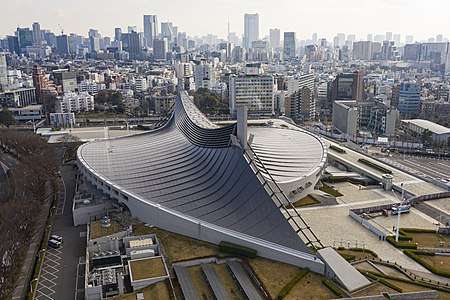
The Yoyogi National Gymnasium is situated in an open area in Yoyogi Park on an adjacent axis to the Meiji Shrine. The gymnasium and swimming pool were designed by Tange for the 1964 Tokyo Olympics, which were the first Olympics held in Asia. Tange began his designs in 1961 and the plans were approved by the Ministry of Education in January 1963. The buildings were placed to optimize space available for parking and to permit the smoothest transition of incoming and outgoing people.[22]
Inspired by the skyline of the Colosseum in Rome, the roofs have a skin suspended from two masts. The buildings were inspired by Le Corbusier's Philips Pavilion designed for Brussel's World Fair and the Ingalls Rink Yale University's hockey stadium by Eero Saarinen (both structures completed in 1958). The roof of the Philips pavilion was created by complex hyperbolic paraboloid surfaces stretched between cables. In both cases Tange took Western ideas and adapted them to meet Japanese requirements.[23]
The gymnasium has a capacity of approximately 16,000 and the smaller building can accommodate up 5,300 depending on the events that are taking place. At the time it was built, the gymnasium had the world's largest suspended roof span. Two reinforced concrete pillars support a pre-stressed steel net onto which steel plates are attached. The bottom anchoring of this steel net is a heavy concrete support system which forms a distinct curve on the interior and exterior of the building. In the interior, this structural anchor is used to support the grandstand seats. The overall curvature of the roof helps protect the building from the damaging effects of strong winds.[22]
Tange won a Pritzker Prize for the design; the citation described the gymnasium as "among the most beautiful buildings of the 20th century".[24]
Supreme Court Building of Pakistan
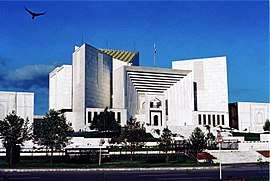
The Supreme Court of Pakistan Building is the official and principal workplace of the Supreme Court of Pakistan, located in 44000 Constitution Avenue Islamabad, Pakistan.[25] Completed in 1993, it is flanked by the Prime Minister's Secretariat to the south and President's House and the Parliament Building to the north.
Designed by Tange, to a design brief prepared by the PEPAC, the complex was engineered and built by CDA Engineering and Siemens Engineering.[26]
Osaka Exposition 1970
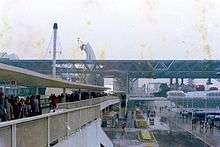
In 1965 the Bureau International des Expositions decided that Japan should host the 1970 Exposition. 3.3 square kilometres (1.3 sq mi) of land in the Senri Hills near Osaka were put aside for its use. Tange and Uzo Nishiyama were appointed as planners for the masterplan by the Theme Committee. Tange assembled a group of twelve architects to design the infrastructure and facilities for the Expo.[27]
At the centre of the Expo was the Festival Plaza. Tange conceived that this plaza (with its oversailing space frame roof) would connect the display spaces and create a setting for a "festival". The plaza divided the site into a northern zone for pavilions and a southern zone for administration facilities. The zones were interconnected with moving pathways.[28]
Architectural circle
Congrès International d'Architecture Moderne
Tange's first placing in the design competition for the Hiroshima Peace Memorial Park gained him recognition from Kunio Maekawa. The elder architect invited Tange to attend the Congrès International d'Architecture Moderne (CIAM). Founded in 1928 this organization of planners and architects had initially promoted architecture in economic and social context, but at its fourth meeting in 1933 (under the direction of Le Corbusier) it debated the notion of the "Functional City". This led to a series of proposals on urban planning known as "The Athens Charter". By the 1951 CIAM meeting that was held in Hoddesdon, England, to which Tange was invited, the Athens Charter came under debate by younger members of the group (including Tange) who found the Charter too vague in relation to city expansion. The "Athens Charter" promoted the idea that a city gains character from its continual changes over many years; this notion was written before the advent of mass bombings and the Second World War and therefore held little meaning for Tange who had evidenced the destruction of Hiroshima. The discussions at Hoddesdon sowed discontent within CIAM that eventually contributed to its breakup after their Dubrovnik meeting in 1956;[29] the younger members of CIAM formed a splinter group known as Team X, which Tange later joined. Tange presented various designs to Team X in their meetings. At a 1959 meeting in Otterlo, Holland, one of his presentations included an unrealised project by Kiyonori Kikutake; this project became the basis of the Metabolist Movement.[30]
When Tange travelled back to Japan from the 1951 CIAM meeting, he visited Le Corbusier's nearly complete Unité d'Habitation in Marseilles, France. He also looked at the sketches for the new capital of Punjab at Chandigarh, India.[11]
Tokyo World Design Conference and urban planning
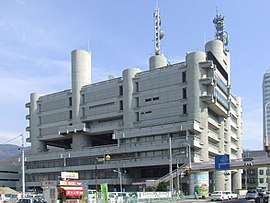
Tange had left the Team X Otterlo conference early to take up a tenure at Massachusetts Institute of Technology. His experiences at the conference may have led him to set his fifth year students a project to design a 25-thousand-person residential community to be erected in Boston over the bay.[31] The scheme comprised two giant A-frame structures that resembled Tange's competition entry for the World Health Organisation's headquarters on Lake Geneva. Both this scheme and the earlier ones by Kikutake formed the basis of Tange's speech to the Tokyo World Design Conference in 1960. In his speech he used words such as "cell" and "metabolism" in relation to urban design. The Metabolist movement grew out of discussions with other members of the conference. Amongst them were Kisho Kurokawa, Junzo Sakakura, Alison and Peter Smithson, Louis Kahn, Jean Prouvé, B. V. Doshi and Jacob Bakema. The conference ended with Tange's presentation of the Boston plan and his own scheme, "The Tokyo Plan – 1960".[32]
Tange argued that the normal urban pattern of a radial centripetal transportation system was a relic of the Middle Ages and would not handle the strain placed upon it by the world's mega cities, which he qualified as those with populations greater than 10 million.[33] Rather than building up a city from a civic centre, Tange's proposal was based on civic axis, developing the city in a linear fashion.[34] Three levels of traffic, graded according to speed, would facilitate the movement of up to 2.5 million people along the axis, which would be divided into vertebrae-like cyclical transportation elements. The sheer size of the proposal meant that it would stretch out across the water of Tokyo Bay.[35] Tange's proposals at this conference play a large part in establishing his reputation as "The West's favourite Japanese architect".[36]
In 1965 Tange was asked by the United Nations to enter a limited competition for the redevelopment of Skopje, which was at that time a city of Socialist Federal Republic of Yugoslavia. The town had been heavily destroyed by an earthquake in 1963. Tange won 60% of the prize; the other 40% was awarded to the Yugoslav team. Tange's design furthered ideas put forward in the earlier "Tokyo Plan".[37]
Tange further developed his ideas for expandable urban forms in 1966 when he designed the Yamanashi Broadcasting and Press Centre in Kōfu. It was designed for three media companies: a newspaper printing plant, a radio station and a television studio. To allow for future expansion Tange grouped the similar functions of three offices together in three zones. The newspaper printing machinery was on the ground floor, sealed studios on the upper floors and offices on glass walled floors surrounded by balconies. The services, including stairs and lifts, are housed in 16 reinforced concrete columns that are of five-metre (17 ft) diameter. Space was left between the cluster of functional space to allow for future expansion, although these have been used for gardens and terraces.[38]
Urbanists and Architects Team
Tange's inspiration for his design office came from his friend Walter Gropius who he had first met at the CIAM meeting in 1951. While lecturing at the Bauhaus, Gropius had placed great importance on teaching architects, especially imparting on them the concept of working together as a team. The Urbanists and Architects Team was founded in 1961 and became Kenzō Tange Associates. Tange promoted a very flat hierarchy in the practice: partners were equal in importance and were encouraged to participate in every project. Multiple options were developed simultaneously, and research on individual schemes was encouraged.[39]
Later career
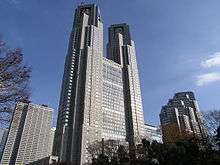
During the 1970s and 1980s Tange expanded his portfolio to include buildings in over 20 countries around the world. In 1985, at the behest of Jacques Chirac, the mayor of Paris at that time, Tange proposed a master plan for a plaza at Place d'Italie that would interconnect the city along an east-west axis.[40]
For the Tokyo Metropolitan Government Building, which opened in 1991, Tange designed a large civic centre with a plaza dominated by two skyscrapers. These house the administration offices whilst a smaller seven-storey building contains assembly facilities. In his design of a high tech version of Kofu Communications Centre, Tange equipped all three buildings with state-of-the-art building management systems that monitored air quality, light levels and security. The external skin of the building makes dual references to both tradition and the modern condition. Tange incorporated vertical and horizontal lines reminiscent of both timber boarding and the lines on semiconductor boards.[41]
Tange continued to practice until three years before his death in 2005. He disliked postmodernism in the 1980s and considered this style of architecture to be only "transitional architectural expressions".[42] His funeral was held in one of his works, the Tokyo Cathedral.[43]
Tadao Ando, one of Japan's greatest living architects, likes to tell the story of the stray dog, a stately akita, that wandered into his studio in Osaka some 20 years age, and decided to stay. "First, I thought I would call her Kenzo Tange; but then I realised I couldn't kick Kenzo Tange around. So I called her Le Corbusier instead."
— Obituary in The Guardian[42]
Legacy
The modular expansion of Tange's Metabolist visions had some influence on Archigram with their plug-in mega structures.[44] The Metabolist movement gave momentum to Kikutake's career. Although his Marine City proposals (submitted by Tange at CIAM) were not realised, his Miyakonojo City Hall (1966) was a more Metabolist example of Tange's own Nichinan Cultural Centre (1962).[45] Although the Osaka Expo had marked a decline in the Metabolist movement, it resulted in a "handing over" of the reigns to a younger generation of architects such as Kazuo Shinohara and Arata Isozaki.[46]
In an interview with Jeremy Melvin at the Royal Academy of Arts, Kengo Kuma explained that, at the age of ten, he was inspired to become an architect after seeing Tange's Olympic arenas, which were constructed in 1964.[47]
For Reyner Banham, Tange was a prime exemplar of the use of Brutalist architecture. His use of Béton brut concrete finishes in a raw and undecorated way combined with his civic projects such as the redevelopment of Tokyo Bay made him a great influence on British architects during the 1960s.[42] Brutalist architecture has been criticised for being soulless and for promoting the exclusive use of a material that is poor at withstanding long exposures to natural weather.[48]
He received the AIA Gold Medal in 1966.
Tange's son Paul Noritaka Tange graduated from Harvard University in 1985 and went on to join Kenzō Tange Associates. He became the president of Kenzo Tange Associates in 1997 before founding Tange Associates in 2002.[49]
Awards
- RIBA Gold Medal (1965)[50]
- American Institute of Architects Gold Medal (1966)[51]
- French Academy of Architecture Grand Medal of Gold (1973)[52]
- Pritzker Architecture Prize (1987)[53][54]
- Olympic Diploma of Merit (1965)[55]
Footnotes
- Caves, R. W. (2004). Encyclopedia of the City. Routledge. p. 657. ISBN 978-0415862875.
- Stewart (1987), p. 170
- Stewart (1987), p. 171
- Reynolds (2001), p. 126
- "Biography: Kenzo Tange, 1987 Laureate". The Pritzker Architecture Prize. New York, United States: The Hyatt Foundation. 1987. Archived from the original on 7 January 2010. Retrieved 13 March 2010.
- Yorifusa (2003), p. 29
- Norioki (2003), p. 92
- Norioki (2003), p. 96
- Diedfendorf, Hein & Yorifusa (2003), p. 95
- Diedfendorf, Hein & Yorifusa (2003), p. 98
- Stewart (1987), p. 175
- Kulterman (1970), p. 17
- Kulterman (1970), p. 18
- Diedfendorf, Hein & Yorifusa (2003), p. 197
- Stewart (1987), p. 207
- Japan Architect (2005), p. 100
- Kulterman (1970), p. 56
- Kulterman (1970), p. 28
- Stewart (1987), p. 197
- Kulterman (1970), p. 92
- Banham (1978), p. 82
- Kulterman (1970), p. 204
- Stewart (1987), p. 218
- "Announcement: Kenzo Tange, 1987 Laureate". The Pritzker Architecture Prize. New York, United States: The Hyatt Foundation. 18 March 1987. Retrieved 9 November 2013.
- Google. "The address and location of the Supreme Court of Pakistan". Google. Google Maps. Retrieved 5 January 2014.
- Govt. Pakistan. "Supreme Court Building". Govt. Pakistan. Supreme Court of Pakistan press. Archived from the original on 1 February 2017. Retrieved 5 January 2014.
- Kulterman (1970), p. 282
- Kulterman (1970), pp. 286–94
- Stewart (1987), pp. 173–76
- Stewart (1987), pp. 176–77
- Stewart (1987), p. 177
- Stewart (1987), pp. 179–81
- Kulterman (1970), p. 119
- Kulterman (1970), p. 123
- Kulterman (1970), p. 128
- Stewart (1987), p. 182
- Kulterman (1970), p. 262
- Kulterman (1970), p. 246
- Kulterman (1970), p. 8
- Ayers (2004), p. 213
- Doordan (2002), p. 274
- Glancey, Jonathan (23 March 2005). "Obituary: Kenzo Tange". The Guardian. London, United Kingdom: Guardian News and Media Limited. ISSN 0261-3077. Retrieved 15 June 2010.
- "NBM Media". Retrieved 15 October 2010.
- Frampton (1990), p. 282
- Stewart (1987), p. 216
- Frampton (1990), p. 283
- Kuma, Kengo (2004). "Kengo Kuma's craft" (Interview). Interviewed by Jeremy Melvin. London: Royal Academy of Arts. Archived from the original on 28 October 2010. Retrieved 16 June 2010.
- Dalrymple, Theodore (Autumn 2009). "The Architect as Totalitarian". City Journal. New York, United States: Manhattan Institute for Policy Research. 19 (4). ISSN 1060-8540. Retrieved 14 October 2010.
- "International Luxury Lifestyle Forum". 2010. Archived from the original on 20 March 2011. Retrieved 24 October 2010.
- Almanac of Architecture & Design 2006, 7th ed. (Greenway, 2006: eds. James P. Cramer & Jennifer Evans Yankopolus), p. 164.
- Richard Guy Wilson, The AIA Gold Medal (McGraw-Hill, 1984), p. 202.
- AIA Journal, Vol. 60 (American Institute of Architects, 1973), p. 62.
- Biography: Kenzo Tange: 1987 Laureate, Pritzker Architecture Prize.
- Sam Hall Kaplan, Tange's Honor Is Well-Deserved, Los Angeles Times (March 22, 1987).
- Findling, John E.; Pelle, Kimberly D. (2004). Encyclopedia of the Modern Olympic Movement. Westport: Greenwood Press. p. 172.
References
- Ayers, Andrew (2004) [2004]. The Architecture of Paris: An Architectural Guide. London, United Kingdom: Edition Axel Menges. ISBN 3-930698-96-X.
- Banham, Reyner (1978) [1975]. Age of the Masters: A Personal View of Modern Architecture (Revised ed.). London, United Kingdom: Architectural Press. ISBN 0-85139-395-0.
- Diefendorf, Jeffry M; Hein, Carola; Yorifusa, Ishida, eds. (2003). Rebuilding Urban Japan After 1945. Hampshire, United Kingdom: Palgrave MacMillan. ISBN 0-333-65962-7.
- Doordan, Dennis P (2002) [2001]. Twentieth Century Architecture. London, United Kingdom: Calmann & King. ISBN 0-8109-0605-8.
- Frampton, Kenneth (1990) [1980]. Modern Architecture a Critical History (Revised and enlarged ed.). London, United Kingdom: Thames and Hudson. ISBN 0-500-20201-X.
- Kultermann, Udo (1970). Kenzo Tange. London, United Kingdom: Pall Mall Press. ISBN 0-269-02686-X.
- Reynolds, Jonathan McKean (2001). Maekawa Kunio and the Emergence of Japanese Modernist Architecture. London, United Kingdom: University of California Press. ISBN 0-520-21495-1.
- Stewart, Dennis B (2002). The Making of a Modern Japanese Architecture: From the Founders to Shinohara and Isozaki. New York, United States: Kodansha International. ISBN 4-7700-2933-0.
- "Docomomo Japan: The 100 Selections". The Japan Architect. Japan: The Japan Architect Company (57). Spring 2005. ISSN 0448-8512.
External links
| Wikimedia Commons has media related to Kenzo Tange. |
- Tange Associates official website
- The Kenzō Tange Archive. Gift of Mrs. Takako Tange, 2011. Frances Loeb Library, Harvard University Graduate School of Design.